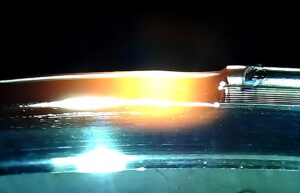Laser Wire Welding in Zero-G
Simulation of Laser-based additive manufacturing under reduced gravity

Description
At the Institute of Multiscale Simulation, we investigate the physics of many-body systems, experimentally, numerically and theoretically. In the “LADA” project, we are working on the laser-based additive manufacturing of metal components for use on future extraterrestrial missions under low gravity conditions.
In laser wire welding, a metal wire is melted using a laser as an energy source, applied to a metallic base, which is also heated by the laser, and welded to it. The line-by-line or layer-by-layer application and subsequent solidification of the molten metal creates a three-dimensional component, similar to the way a 3D printer extrudes plastics. While the additive manufacturing of plastic components is already being tested on the International Space Station, the – technically more important – production of metal components has not yet been investigated. Our project aims to help open up the process of laser wire welding for space missions (in zero gravity) and applications under reduced gravity (Moon, Mars). The process could make it possible to manufacture necessary components directly on site, for example on space stations or future moon and Mars missions, thereby increasing flexibility and reducing the number of spare parts to be carried.
In addition to material-specific variables such as melting point and absorption behavior, process parameters like laser power, beam profile, feed rate, wire feed or shielding gas flow are key factors influencing the process result and need to be controlled. The optimization of the process parameters is the subject of extensive research work. While such processes have already been well studied on earth and are technically mastered in many cases, the behavior under zero gravity is largely unknown. For example, gravity-driven convection effects no longer apply and the merging of the molten metal is no longer supported by gravity. Work on arc welding under microgravity shows a clear influence of weightlessness on the shape of the molten pool and solidification as well as the behavior of bubbles in the melt. Clear gravitational influences on the process behavior can also be demonstrated in laser beam welding. Studies on laser wire welding are not yet available. We are investigating how essential phenomena – such as the wetting behavior of the molten material and the convective flows that occur in it – are influenced by gravity by closely interlinking experiments in weightlessness and simulations.
Tasks
- Development and implementation of algorithms to simulate the behavior of molten metals in microgravity using SPH (Smoothed Particle Hydrodynamics).
- Simulation of laser welding processes, including the absorption of laser light, phase transitions during melting and solidification, and mixing processes.
- Comparison of simulation results with experimental data to improve the understanding of the laser welding process.
- Participation in process optimization through well-founded predictions and improvement of future process control.
Profile
- Completed studies (Master) in physics, mathematics, engineering or comparable.
- Interest in a current field of research and the realization of laser-based additive manufacturing in microgravity.
- Sound programming skills, ideally in C++ or Python, and the willingness to develop these further.
- Experience in the simulation of multi-particle systems, e.g. using SPH, is an advantage but not essential.
We offer
- Fully funded PhD position
- Development opportunities for the implementation of new ideas
- Flexible working hours
- Barrier-free office building
If you would like to take on a responsible role in researching this new method as a PhD student, then apply now and bring your expertise to our team! Please send your detailed application or questions with the subject “LADA” to:
Dr. Achim Sack, mss-recruitment@fau.de
Your application must include: CV, certificates and a letter of motivation outlining your interests, research background and suitability for the advertised position.